Thermostatic valve for a heating radiator: purpose, types, principle of operation + installation
A standard heating system cannot be called flexible.To adjust the operating parameters of batteries, various devices have been invented.
One such device is a thermostatic valve for heating radiators. It is used to regulate the heat transfer of the system depending on weather conditions. In this article, we will analyze the design and operating principle of a thermal valve, and get acquainted with the existing varieties and main manufacturers.
We will also provide installation recommendations, providing the material with visual photos and video reviews on the installation and response speed of devices of various brands.
The content of the article:
Why is a thermostatic valve needed?
The valve solves two problems: maintains the room temperature at a comfortable level and saves energy.
But in order for it to really cope with such functions, you need to understand in what cases the device is appropriate and how to install it correctly.
If in the middle of winter there is a need to open the windows so that the temperature in the room drops to an acceptable level, a thermostat is definitely needed. But it won’t help when the radiators are barely warm—it will probably make it even colder.
In the second case, it is better to try to regulate the temperature in the room differently: change the volume of coolant in each radiator, adjust the operation of the boiler (for a large area), select optimal circulation pump or adjust the operation of an existing one.
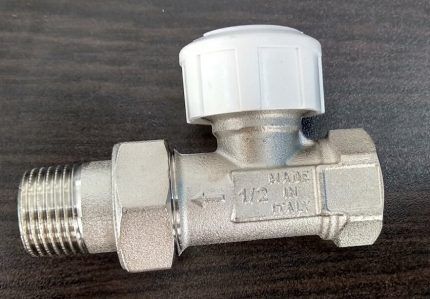
As a temporary measure, control valves can be used. But it is not recommended to use ball valves for these purposes.
Design and operating features of the device
Let's look at how a thermostatic valve works and on what principle it works.
How does a thermal valve work?
The device consists of two main working elements - a valve and thermostatic head. The first is most often made of brass, sometimes nickel-plated, its lower part blocks the pipe, and its upper part continues the pressure rod and spring.
Valves are also available in bronze (nickel-plated or chrome-plated), as well as stainless steel. The latter are rare and expensive.
What happens inside the valve? The head device contains a sensitive element. It is located in a cavity with gas or liquid (bellows).
Heating provokes expansion in this environment, the element is pushed forward, pressing on the rod, spring, and later on the valve. The force of pressure determines the degree of overlap.
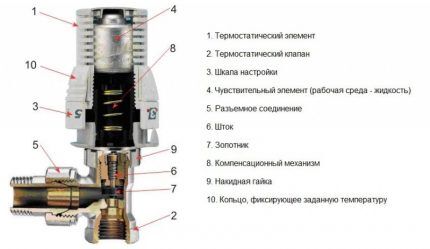
An additional part of the thermostat is a plug or handle with a scale. Some devices have electronic controls.
Operating principle of the device
Let's take a closer look at the working principle of battery thermostatic valves.The mechanics of their action looks schematically like this: when the temperature of the coolant or the environment changes, the gas or liquid in the head reacts to these fluctuations.
The sensing element acts on the pressure rod, and it goes up or down. When the rod moves down, the valve blocks the flow of coolant, which stops the flow of heat and slows down the circulation rate. No heat enters the battery, so the room temperature does not rise.
And here it is important to distinguish a thermostatic valve from a control valve. The latter can reduce the valve capacity and thus regulate the temperature of the batteries.

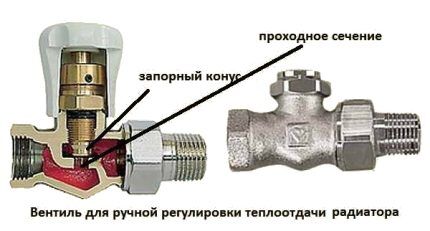
Let's look at the operating principle of a thermal valve using an example. So, set the device to the recommended temperature of 20 degrees. This is usually a three or the largest point on the regulator scale.
What happens inside the device? If the surrounding air heats the head to 21 degrees, i.e. increases the set temperature by 1 degree, it presses the rod, the flow of coolant into the battery is completely blocked by the valve.
The radiator does not heat up and the room temperature begins to drop. When the ambient temperature drops to 19 degrees, the thermal valve will open and the battery will begin to heat up.
We understand the types of devices
According to the method of adjustment, valves are divided into mechanical And automatic. The first require manual rotation of the mechanism for narrowing the flow in the pipes.
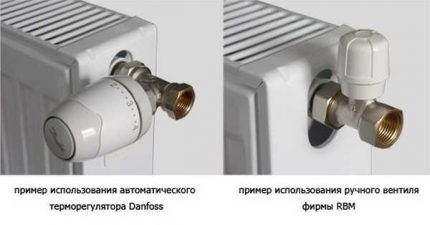
Automatic models do not require manual adjustment. When the temperature around the thermostat decreases, they independently detect this and adjust the coolant flow.
Manufacturers also offer different thermostat designs:
- Common for two-pipe systems - the simplest device. If you need hydraulic linking of radiators along one branch, it is recommended to add a shut-off and control valve to the supply (return) circuit.
- With hidden and exposed hydraulic superstructure — such devices have a coupling with an internal rod, so hydraulic adjustment is possible.
- For single-pipe, gravity systems — due to the increased passage, the throughput of these devices is increased to 5.1 m3/hour, so they can be installed in non-pressure systems.
- 3-way for bypass circuits - are able to regulate and distribute the coolant in conjunction with bypass. When the set temperature reaches the valve, the coolant is sent to the bypass; when it drops, the bypass is partially closed.
The percentage of thermal valves for two pipes is much greater than for single pipes, and the latter in our country are about 80%.
This is due to the fact that the device was originally invented for the former, where the coolant is distributed among the devices forcibly under high pressure. Pre-setting by valves is designed to distribute pressure evenly throughout the system.
Only some manufacturers have valves for single pipes - Heiz, Danfoss, Heimeier, Oventrop.
Conventional “two-pipe” thermostats cannot be used in single-pipe circuits.: they have a lower throughput, they are able to operate only with a large difference in pressure between the supply and return, so there will be a risk of redirecting the coolant to the bypass.
Externally, “one-pipe” valves are larger in size.
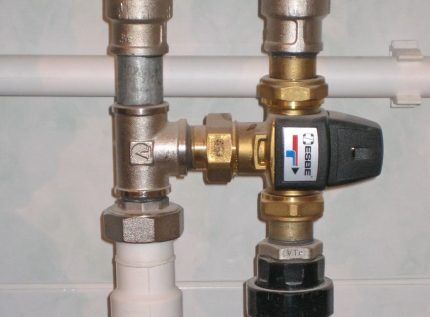
Thermostatic valves also differ in shape. They can be straight, angular or included in sets with jumpers for pipes. Direct ones are suitable for regular batteries. Angular ones are needed in schemes with lower pipe connections, when the CO is partially disguised under the floor.
A separate type of thermal valves is electronic. They have wider functionality than regular ones. With their help, you can set different room temperatures for each day of the week and even hourly.

Electronic thermostats provide significant savings in coolant consumption. If there is no one in the apartment or house from 8 am to 6 pm, the device will properly maintain the minimum temperature. And when the owners arrive, it will heat the premises to a comfortable level.
Valves with anti-vandal casing are also available for sale. They are reliably protected from unqualified intervention and are suitable for installation both in a home with small children, and in kindergartens and schools.
Features of installation and connection of the valve
The device itself is simple, but special attention must be paid to installing and calibrating the thermostatic valve on radiators. Correct installation will ensure the accuracy of the device.
What factors are considered during installation? A type of thermal valve is for one-pipe or two-pipe. Plus the direction of movement of the coolant - it comes from below or from above.
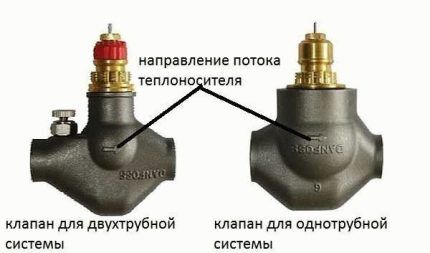
Hot water supply pipes to the battery are supplied in different ways. It depends on the heating scheme. The placement of plugs and thermostats are also different. The general recommendation for most thermostat models is to place them within 40-60 cm from the floor level.
The installation algorithm is approximately as follows:
- Disconnect the radiator from the heating system and drain the water.
- We remove the section of the horizontal pipe and the tap too.
- The thermostat can also be mounted in the radiator cap if a shut-off valve is installed in front of it. Or make an insert into the horizontal part of the pipe in front of the battery.
- The tightness of the joints is important. We provide this by standard winding of FUM tape onto the threaded area.
The traditional connection diagram is as follows: bypass - ball valve - thermostat.
One more point: there are systems where the coolant moves in different directions in different rooms. This is especially true for U-shaped risers.
Installation nuances for one-pipe and two-pipe systems
IN one-tube hot water circulates through one pipe with radiators connected in series. The coolant pipe goes into the top of the batteries.The latter runs through the installation, exits from below on the same side and is sent to the main highway.
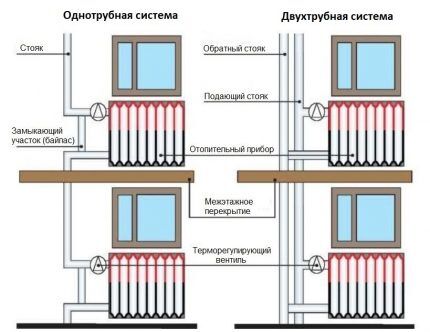
In a one-pipe system, the thermostat is placed on an unregulated bypass. This jumper connects the direct pipe and the return pipe, so hot water moves freely after the pressure is blocked by the valve.
Such a jumper can be welded to the pipe yourself, for which a piece of pipe with a diameter of no more than 8 cm is suitable. In this case, you need to prepare holes in the appropriate places.

In a two-pipe, the coolant flows to radiator through one pipe and out through another. A bypass is not needed; the thermostatic valve must be installed on the water supply pipe.
Rules for adjusting the operation of the device
After installation, you need to adjust the operation of the device. To do this, we first close the windows and doors - we insulate the room to prevent heat leakage.
Then we proceed like this:
- We turn on the heating.
- We set the valve to the position of maximum heat transfer and measure the temperature.
- We are waiting for the room temperature to rise by 5 degrees and become constant.
- Close the valve and wait for a comfortable temperature.
- Then we open the thermostat a little bit until we hear the sound of passing water. The body of the device itself should become warmer.
- The last point needs to be remembered.
In a private home, air must be bleed from the batteries before adjustment.In this case, maximum care must be taken to avoid the release of hot steam.
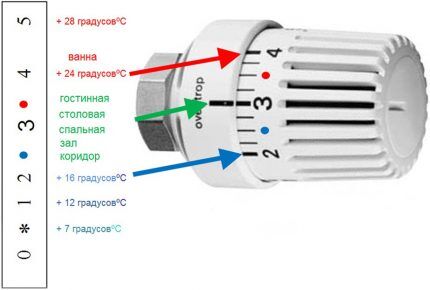
The adjustment starts from the coldest room. It needs to be warmed up well before moving on to other rooms.
Frequent installation errors and possible problems
The first mistake is placing the thermal head vertically. The problem is the hot metal valve under the head: hot air flows upward from it.
This air heats the head, and it mistakenly turns off the radiator. As a result, the battery is almost always disconnected and the room does not warm up. The device must be installed horizontally (“head” into the room).
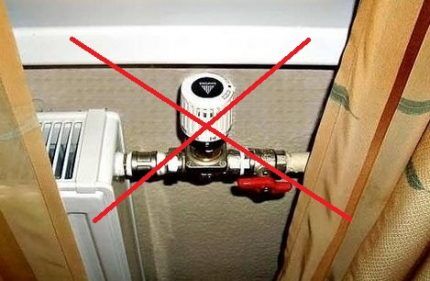
The second mistake is the location of the thermostat where the temperature differs from the real one in the room. Example: in a niche with a battery. In this option, the head will always be “hot”.
A significant malfunction in its operation will also be present when placing curtains behind thick fabric, under window sills, or at the edges of window openings.
If it is impossible to position the thermostat otherwise, a model with a remote sensor will again help out. They differ from conventional devices by the presence of a capillary tube about 2 meters long with a temperature sensor at the end. You can attach such a device on the wall away from the window and radiator.
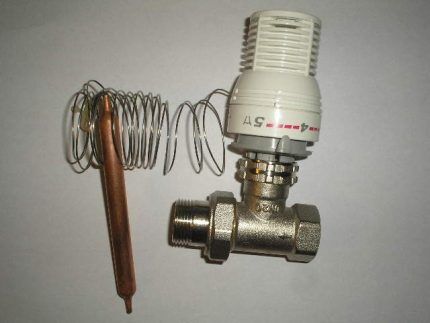
Heads with remote regulators are also available for sale, the installation of which can be done anywhere at a distance of up to 15 m from the battery and valve. There are also electronic heads that are controlled by thermal computers.
The thermostatic valve completely blocks the coolant flow. If in radiant heating system all appliances will do this at the same time, there will be problems with the boiler. A possible solution is bypass valves on the circuits.
If there are 2-3 radiators in a room, does it make sense to install thermostats on each radiator? Will there be conflict between them? In this case, you need to do balancing using tuning valves (ball valves).
Conclusions and useful video on the topic
What is a thermal head, what is it for and how does it work.
Analysis of a finished system with a thermostatic valve.
An experiment on the response speed of thermal heads from 4 manufacturers.
The use of thermal valves for radiators allows you to make the heating system as flexible as possible.
With their help, you can regulate the temperature of individual batteries so as to constantly maintain a comfortable microclimate in the room. But at the same time, it is important to take into account the appropriateness of installing such devices and correctly installing and configuring them.
Are you thinking about installing a thermal valve, but want to clarify a couple of installation points? Ask your questions under this article - our experts and site visitors who use such temperature control equipment will try to answer you in as much detail as possible.
If your heating system is equipped with thermostatic valves, please share your opinion with other users.Tell us, which manufacturer’s equipment did you prefer, is it convenient to use, are you satisfied with the result? Write your recommendations in the comments block, add unique photos of the thermal valve.




With a thermostat, life in an apartment becomes much more comfortable, I know from experience. They heat it in the boiler room, it’s unclear how - they don’t really adjust to the weather outside. During the thaw, they can continue to heat at full blast, and the Sahara just begins in the apartment. With a thermostat, you can simply turn down the temperature to a comfortable temperature. I actually took an electronic one. Yes, it’s more expensive, but the temperature can be accurately set and there are many functions on the clock.
For testing, I took and installed a Giacomini P470 thermal head. It is manually adjusted, there are many divisions, the air temperature in the apartment can be adjusted from +8 to +30. I just don’t understand how it works.
I installed it horizontally as per the instructions. I touch the battery, it is sometimes hot, sometimes warm, but never cold. But the room didn’t seem to be as hot as before, so I had to open the window. For now I’m thinking whether I need to go to other rooms or not.
Of course, place it in other rooms, this is the only way you can fully experience all the advantages of a thermal head, when you can set different temperatures in different rooms. And the thermal head works quite simply - you set the desired temperature, and it independently maintains it, regulating the water supply to the radiator depending on the temperature you set.
How does opening windows for ventilation affect the operation of the thermal head?
What is the correct action in this case?